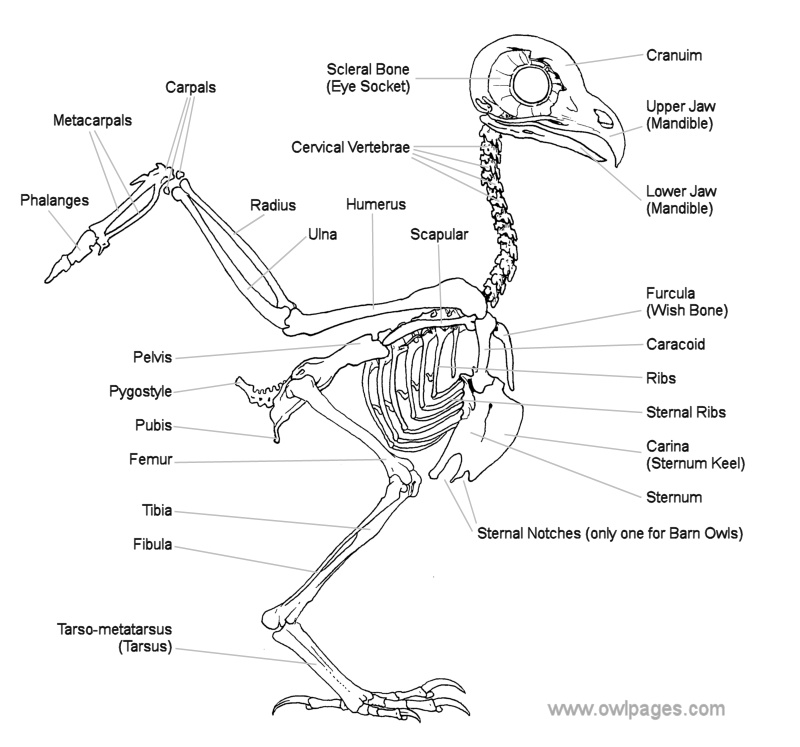
The owl bone structure is a fascinating topic that reveals the unique adaptations of these remarkable birds. Owls, known for their distinctive appearance and nocturnal habits, possess a skeletal structure that is specially designed for their lifestyle. In this article, we will explore the intricacies of owl bone anatomy, how it contributes to their hunting prowess, and why understanding this structure is essential for both researchers and wildlife enthusiasts alike.
Owls are a diverse group of birds belonging to the order Strigiformes. They are characterized by their large, forward-facing eyes, silent flight, and exceptional hearing. The bone structure of owls plays a crucial role in their ability to hunt effectively at night. By examining the unique features of their skeleton, we can gain insight into how these birds have evolved to thrive in various environments.
This article will delve into the various aspects of owl bone structure, including its composition, adaptations, and the implications for their behavior and ecology. We will also provide a detailed overview of owl anatomy, supported by scientific research and expert insights, ensuring that you leave with a comprehensive understanding of this intriguing subject.
Table of Contents
1. Owl Anatomy Overview
The anatomy of owls is specifically tailored to meet their predatory needs. Unlike many birds, owls possess several unique skeletal features that enhance their survival and hunting capabilities. Here are some key components of owl anatomy:
- Skull: Owls have a large, rounded skull that houses their massive eyes, providing excellent vision in low light conditions.
- Beak: Their hooked beak is designed for tearing flesh, which is essential for their carnivorous diet.
- Wings: The bone structure of their wings is adapted for silent flight, which helps them approach prey without detection.
- Feet: Owls have powerful claws that allow them to grasp and kill prey effectively.
2. The Bone Structure of Owls
The bone structure of owls is lightweight yet strong, allowing for both agility and strength. The following points highlight key aspects of their bone structure:
- Hollow Bones: Similar to many bird species, owls have hollow bones that reduce weight without sacrificing strength. This adaptation is crucial for flight efficiency.
- Fusion of Bones: Certain bones in an owl's body are fused together, providing stability and strength while minimizing weight.
- Robust Limb Bones: The limb bones of owls are particularly robust, allowing them to exert significant force when capturing prey.
2.1 The Importance of Bone Density
Bone density plays a vital role in an owl's ability to hunt and fly. Owls possess a higher bone density than many other bird species, which helps them maintain balance and control during flight.
2.2 The Role of the Spine
The spine of an owl is flexible yet rigid, allowing for quick head movements and stability during flight. This adaptability is essential for spotting and capturing prey in the dark.
3. Adaptations in Bone Structure
Owls have evolved several adaptations in their bone structure that enhance their hunting efficiency:
- Head Rotation: Owls can rotate their heads up to 270 degrees due to specialized cervical vertebrae, allowing them to survey their surroundings without moving their bodies.
- Specialized Wing Structure: The broad wings and unique feather arrangement facilitate silent flight, which is vital for stealthy hunting.
- Strong Leg Bones: The strong leg bones support powerful talons that are effective for gripping and killing prey.
4. Functional Aspects of Owl Bones
The functional aspects of owl bones are closely tied to their survival strategies:
- Silent Flight: The unique structure of owl feathers and bones allows for silent flight, minimizing noise while hunting.
- Efficient Hunting: The combination of strong bones and sharp talons enables owls to capture and subdue prey quickly.
- Adaptability: The lightweight bone structure allows owls to thrive in various habitats, from forests to grasslands.
5. Comparison with Other Birds
Comparing the bone structure of owls with other birds provides insight into their unique adaptations:
- Vs. Hawks: While both owls and hawks have strong bones for hunting, hawks rely on speed and agility, whereas owls emphasize stealth.
- Vs. Sparrows: Sparrows have denser bones relative to their size, which aids in rapid flight but limits their hunting capabilities.
- Vs. Penguins: Penguin bones are denser and more robust, designed for swimming rather than flight, highlighting the diversity of adaptations in avian species.
6. Research on Owl Bone Structure
Scientific research on owl bone structure has provided valuable insights into their biology and ecology. Notable studies include:
- Research on the biomechanics of owl flight, highlighting the role of bone structure in silent flight.
- Studies on skull morphology, explaining how the structure supports excellent vision in low light conditions.
- Investigations into the impact of environmental changes on owl bone density and overall health.
7. Conservation Implications
Understanding the bone structure of owls is crucial for conservation efforts:
- Habitat Protection: Preserving natural habitats ensures that owls can thrive and maintain their unique adaptations.
- Health Monitoring: Studying bone structure can help identify health issues in owl populations, allowing for timely conservation actions.
- Public Awareness: Educating the public about the importance of owl anatomy fosters support for conservation initiatives.
8. Conclusion
In conclusion, the owl bone structure is a remarkable example of evolution and adaptation. From their lightweight yet strong bones to specialized features that enhance hunting efficiency, owls are truly unique creatures. By understanding their anatomy, we can appreciate the role these birds play in ecosystems and the importance of conserving their habitats. We encourage you to share your thoughts in the comments below and explore more articles on our site to learn about the fascinating world of wildlife.
Thank you for reading! We hope you found this article informative and engaging. Please visit us again for more insights into the natural world.
ncG1vNJzZmivp6x7o77EnKKepJxjwqx7zaiurKyimq6uhI6orqVlkqS7pnnSramum6Sqv6Z6x62kpQ%3D%3D